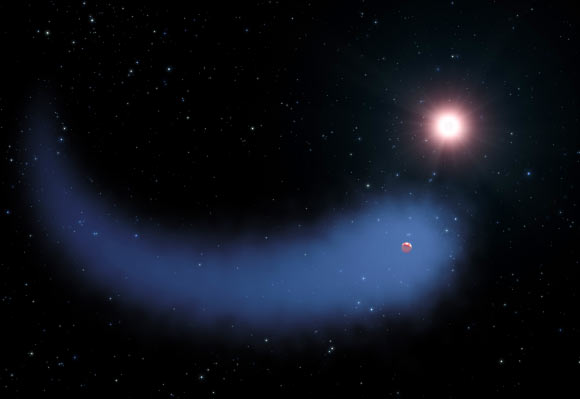Using the NASA/ESA Hubble Space Telescope, a group of astronomers has discovered an enormous cloud of hydrogen dispersing from the warm, Neptune-sized planet exoplanet GJ 436b (also known as Gliese 436b).

This artist’s concept shows the huge cloud of hydrogen bleeding off of the Neptune-sized exoplanet Gliese 436b. Image credit: NASA / ESA / STScI / G. Bacon.
Discovered in August 2004, Gliese 436b orbits a red-dwarf star located in the constellation Leo, around 33.4 light-years away.
The planet has an orbital period of just 2.6 Earth days and a mass approximately 23 times that of our home planet. It is categorized as a warm Neptune because it is much closer to its star (just about 4 million km away) than frigid Neptune is to the Sun.
Gliese 436b has an atmosphere leaves behind a gigantic trail of hydrogen, which is about 50 times the size of the parent star, Gliese 436. A phenomenon this large has never before been seen around such a small planet.
“What we can see is a large cloud of hydrogen gas absorbing the light from a red dwarf star as its exoplanet, Gliese 436b, passes in front. The cloud is created as of result of X-rays emitted from the red dwarf burning off Gliese 436b’s upper atmosphere,” explained Dr Peter Wheatley of the University of Warwick, UK, a co-author on the study published in the journal Nature.
“The cloud forms a comet-like tail as a result of UV light coming from the star pushing on the hydrogen and causing it to spiral outwards.
Because the atmosphere of our planet blocks most UV light, the team needed a space telescope with Hubble’s UV capability and exquisite precision to find the Gliese 436b’s comet-like tail.
“You would have to have Hubble’s eyes. You would not see it in visible wavelengths. But when you turn the UV eye of Hubble onto the system, it’s really kind of a transformation, because the planet turns into a monstrous thing,” said study lead author Dr David Ehrenreich from the Observatory of the University of Geneva in Switzerland.
He added: “this cloud of hydrogen is very spectacular. Although the evaporation rate doesn’t threaten the planet right now, we know that the star was more active in the past. This means that the planet’s atmosphere evaporated faster during its first billion years of existence. Overall, we estimate that it may have lost up to 10 percent of its atmosphere.”
“Around 1,000 metric tons of hydrogen are being burnt off from Gliese 436b’s atmosphere every second; which equates to only 0.1 percent of its total mass every billion years,” Dr Wheatley said.
The same process may explain the disappearance of atmospheres observed on terrestrial exoplanets, which rotate very close to their star and are extremely hot, such as the so-called super-Earths.
“Finding the cloud around Gliese 436b could be a game-changer for characterizing atmospheres of the whole population of Neptunes and super-Earths in UV observations,” said co-author Dr Vincent Bourrier, also from the Observatory of the University of Geneva.
The astronomers suggest that evaporation such as this may also have happened in the earlier history of the Solar System, when the Earth had a hydrogen-rich atmosphere that dissipated.
It is also possible that it could happen to Earth’s atmosphere at the end of our planet’s life, when the Sun swells up to become a red giant and boils off our remaining atmosphere, before engulfing our planet completely.
_____
David Ehrenreich et al. 2015. A giant comet-like cloud of hydrogen escaping the warm Neptune-mass exoplanet GJ 436b. Nature 522, 459-461; doi: 10.1038/nature14501







